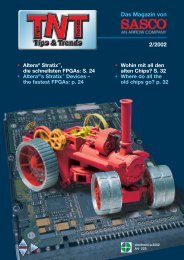steht die TNT als PDF zum Download - ISI-Design
steht die TNT als PDF zum Download - ISI-Design
steht die TNT als PDF zum Download - ISI-Design
Sie wollen auch ein ePaper? Erhöhen Sie die Reichweite Ihrer Titel.
YUMPU macht aus Druck-PDFs automatisch weboptimierte ePaper, die Google liebt.
Programmable Logic<br />
Spannungsregler zu erwarten,<br />
der Versorgungs spannungen<br />
von 3,3 V und<br />
2,5 V und <strong>die</strong> eigentliche<br />
Core-Versorgung von 1,8 V<br />
erlaubt. Im I/O Bereich unterstützt<br />
MAX II <strong>die</strong> Standards<br />
LVTTL und LVCMOS.<br />
Die I/O-Zelle bietet außerdem<br />
Schmitt-Trigger Eingänge,<br />
Begrenzung der<br />
Flankensteilheit (Slew-<br />
Rate), einstellbare Stromstärke<br />
der Ausgangs treiber<br />
und eine „Output-Enable“<br />
(OE)-Ansteuerung pro Pin.<br />
Sie bietet damit deutlich<br />
mehr Flexibilität <strong>als</strong><br />
bisherige CPLDs.<br />
Die Versorgungsspannung<br />
der I/Os kann zwischen<br />
1,5 V und 3,3 V variiert<br />
wer den und ist je nach<br />
Bausteinkomplexität auf<br />
zwei oder vier I/O-Bänken<br />
frei wählbar. Die Derivate<br />
EPM 1270 und EPM 2210<br />
sind auch für PCI Applikationen<br />
ausgelegt und<br />
erlauben den kostengünstigen<br />
Einsatz <strong>als</strong><br />
PCI Bridge. Der Ersatz<br />
von dis kreten 32-Bit<br />
PCI Lösungen ist damit<br />
möglich.<br />
Ein weiteres Schlüsselelement<br />
von MAX II ist <strong>die</strong><br />
geringe Leistungsaufnahme.<br />
Kombiniert man<br />
den kleinen Ruhestrom von<br />
ca. 2 mA mit der äußerst<br />
geringen dynamischen<br />
Leistungsaufnahme,<br />
ergeben sich im Betrieb<br />
Werte, <strong>die</strong> unter denen<br />
der Wettbewerbsprodukte<br />
liegen.<br />
Damit sind auch batteriebe<br />
triebene Handheld-<br />
Appli kationen mit MAX II<br />
realisierbar.<br />
Ab August 2004 sind erste<br />
Muster des EPM 1270<br />
zu erwarten. Bis Anfang<br />
2005 sind alle Derivate in<br />
Produktionsstückzahlen<br />
geplant. Ein MAX II Low-<br />
Cost Entwicklungs-Kit<br />
ist für September 2004 in<br />
Vorbereitung. Software-<br />
Support für MAX II<br />
inklusive Programmierung<br />
ist seit der Version 4.0 SP1<br />
der Quartus II Software<br />
und der kostenlosen<br />
Webedition gegeben.<br />
Neben dem industriellen<br />
Temperaturbereich (- 40 °C<br />
bis + 85 °C) sind in naher<br />
Zukunft auch Derivate für<br />
erweiterte Temperaturen<br />
(- 40 °C bis + 125 °C)<br />
geplant.<br />
the I/O cell offers Schmitt-<br />
Trigger capabilities as well<br />
as programmable slew rate<br />
control, selectable current<br />
drive strength and one<br />
Output Enable (OE) control<br />
logic per pin. This offers<br />
the user more flexibility<br />
than any other previous<br />
CPLD generation.<br />
The I/O voltage can<br />
be selected in a range<br />
between 1.5 V and 3.3 V<br />
spread among two or four<br />
I/O banks based on device<br />
complexity. EP 1270 and<br />
EPM 2210 devices have<br />
been designed for PCI<br />
applications. This enables<br />
these MAX II devices to<br />
work as low cost PCI<br />
bridges and allows the<br />
replacement of discrete<br />
32 bit PCI solutions.<br />
Another key element<br />
of MAX II is reduced<br />
power consumption.<br />
The standby current of<br />
2 mA, together with a low<br />
dynamical power, results<br />
in very low overall power<br />
consumption compared<br />
to the competition. This<br />
makes MAX II suitable <strong>als</strong>o<br />
for handheld applications.<br />
First samples of the<br />
EPM 1270 are expected<br />
for August 2004. Volume<br />
production quantities for<br />
all products are planned<br />
for the first quarter of<br />
2005. A low-cost MAX II<br />
Development Kit is<br />
scheduled for September.<br />
Software support for<br />
MAX II including pin-out<br />
and programming support<br />
has been available since<br />
Version V4.0SP1 of<br />
Quartus II and the no-cost<br />
Webedition.<br />
MAX II devices will be<br />
available in industrial<br />
temperature ranges (- 40 °C<br />
to + 85 °C). Extended<br />
temperature versions<br />
(- 40 °C bis + 125 °C) are<br />
expected after production<br />
ramp up.<br />
Information: 02/04/01




